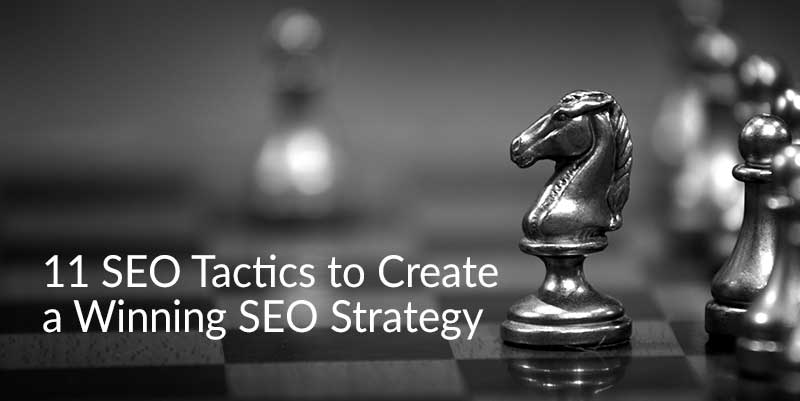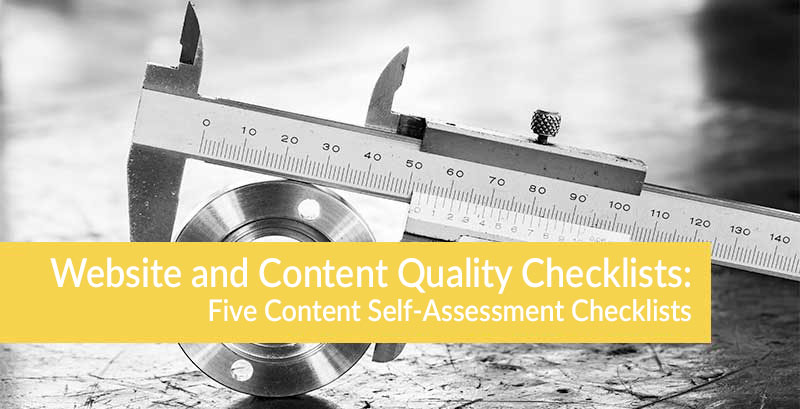Learn how to define an SEO strategy to achieve your website goals
An SEO strategy is an approach or process that helps improve search engine rankings. A successful SEO strategy is key to improving your organic search traffic.
Improved search engine results, consistent organic search results, and a page one ranking on Google do not happen by accident. This takes a concentrated effort of fine-tuning, reviewing, and tweaking your SEO strategy.
Your SEO strategy must be specific to your website, target demographic, products, services, and goals. There is no such thing as a cookie-cutter SEO strategy or “buying an SEO strategy”.
With our 11 SEO tactics for creating a winning strategy, you can create a customized SEO strategy specific to your website goals.
What is an SEO Strategy?
An SEO strategy is the process, steps, and approach used to improve search engine rankings and organic search results for a website or specific content.
An SEO strategy should inform the content you create (including webinars, ebooks, whitepapers, etc.), your website design, social media posts and strategy, and each page on your website.
Remember, while SEO stands for search engine optimization, simply “doing” SEO is not enough. You need a strategy based on the fundamentals of SEO, search, and knowing your target demographic.
11 SEO Tactics to Create a Winning SEO Strategy
Use these 11 SEO tactics to create your winning SEO strategy:
- Learn about SEO
- Know your keywords
- Optimize your on-page SEO
- Focus on page experience
- Optimize technical SEO
- Make social media count
- Audit your PPC campaigns
- Remember the past
- Get to know your audience
- Make your website look good
- Write quality content
1. Learn About SEO
SEO is the specialized approach that supports your website in standing out from your competitors. On-page, off-page, and technical SEO work together to help you rank in search engine results.
To learn about SEO, read Back to SEO Basics: 10 Keys to SEO and Getting Found
To learn about SEO, sign up for The Know Agency 8-Week SEO Basics Course
2. Know Your Keywords
Keyword research tells you the questions people have, the problems they need solved, and the content you need to provide to help them. Keywords are the words, questions, and phrases people type into or ask of search engines. Knowing your keywords and using them correctly is critical to ranking well in organic and paid search and to connecting with your audience.
To know your keywords, do these 5 keyword research steps:
- Use a free keyword tool to find keywords with significant monthly search volume.
- Use Google to learn what questions people are asking.
- Identify your competitors’ keywords so you can compete directly with your competitors.
- Use Google Search Console to learn how people find information about you.
- Use AlsoAsked.com to find the questions people are asking about your keyword search terms.
To know your keywords, read Stop Overcomplicating SEO and Keywords: Find Your 20 Keywords for 2020 In 5 Easy Steps.
3. Optimize Your On-Page SEO
On-page SEO includes page formatting, keywords, website layout, content structure, links, image tags, meta descriptions, and more. An optimal on-page SEO strategy makes it easy for search engines to give people relevant answers to their questions.
To optimize your on-page SEO, use these 5 SEO tactics:
- Use internal links: make sure every page includes relevant internal links with anchor text that uses your page keyword.
- Use image ALT tags: every image needs an ALT tag that describes the image and includes your page keyword.
- Write unique H1 tags: H1 tags help search engines and readers understand what the page is about.
- Write unique titles: the page title is the first thing readers see in search engine results and Google uses the page title to understand the page topic.
- Write unique meta descriptions: the meta description is displayed below your URL and page title in the search engine results. Include a call to action, your page keyword, and tell readers what they will learn from your page.
Download our SEO Checklist and use it to optimize your on-page SEO.
4. Focus on Page Experience
Google is putting a priority on ensuring every search result provides a positive page experience. The Google Page Experience algorithm will be live in May – and this means you need to focus on optimizing the page experience for your readers and Google.
Page experience is a set of metrics that measure user friendliness of web pages. The better the user page experience, the better your chance of a positive Google ranking.
To optimize page experience, focus on these 4 page experience metrics:
- Mobile-friendliness: use the Google Mobile-Friendly Test to learn how mobile friendly your site is.
- Safe browsing: in the Google Search Console, open the Security Issues Report to learn the safe browsing status of your website.
- HTTPS: check to see if your website connection is secure and if not, learn how to secure your website with HTTPS.
- No intrusive interstitials: make sure your ads and pop-ups are easy to close and do not impact page accessibility and mobile friendliness. Compare your interstitials to the examples provided by Google.
Read Google, Page Experience, Core Web Vitals, and Your Website.
Download our Google Page Experience checklist and use it.
5. Optimize Technical SEO
Technical SEO tells search engines that your website exists, which pages are important, and helps search engines understand your content. Key technical SEO factors include accessibility, crawlability, an XML sitemap, site speed, site security, and mobile friendliness. The easier it is to find and read your website, the better the probability of ranking high in search engine results pages (SERPs).
To optimize technical SEO, use our 8-step technical SEO checklist in What is Technical SEO? An 8 Step Checklist to Optimize Technical SEO.
6. Make Social Media Count
Social media helps you build connections, create communities, and provide customer service. The social signals from your Facebook and Twitter posts can help support your SEO strategy and improve your search engine ranking.
To make social media count and use social channels correctly, remember these 5 tips on posting social media content:
- Only post content that is useful to your audience.
- Don’t use trending hashtags and topics if they have nothing to do with your audience.
- Remember that social media is all about being social. Respond to comments and interact with your followers.
- Think of your keyword research and post content that helps your audience solve their problems and answers their questions.
- Show your personality. B2B relationships require a personal connection. Make it easy for your followers to get to know your team.
To learn more about social media and how it fits into your SEO strategy, read:
- What are Social Signals? 7 Ways to Improve Social Signals
- How To Use SEO and Social Media Effectively
- The Latest in SEO and Digital Marketing: 6 SEO Strategies That Work
7. Audit Your PPC Campaigns
A PPC audit gives you actionable feedback you can use to strengthen your PPC campaign. It’s important to remember that your PPC campaign is part of your SEO strategy. Regularly auditing your PPC campaign is the easiest way to catch errors, find overlooked opportunities, and to capitalize on changing search intent and demographics.
To audit your PPC campaigns, read Google Ads and Bing PPC Audit Checklist: How To Audit Your PPC Campaign for details on these 7 PPC campaign audit steps:
- Know your PPC goals: knowing why you’re running a PPC campaign should drive your PPC strategy.
- Review your PPC campaign structure and settings: make sure your campaign and ad groups use a strategy that gives you control over all campaign details from the high-level to the granular.
- Keyword research: the right keywords drive the success of your PPC campaigns. Start with identifying 1-5 relevant keywords for each ad group that are aligned with ad themes and goals. Regularly review these keywords and adjust them as you learn what does and doesn’t work.
- PPC ad review: make sure every aspect of your ad, including the URL, headline, description, and ad copy speak to your target readers. Make A/B testing a priority and don’t be afraid to rethink your ad language and messaging.
- PPC landing page review: your landing page needs to work quickly to convert and drive sales. Make sure your landing page is clear and matches the messaging of your PPC ads.
- PPC tracking and testing review: PPC tracking and testing tell you what is and isn’t working. Tracking conversions and correlating these to your ad and landing page test data tells you how to manage your PPC campaign to keep it working for you.
- PPC script auditing: write or use existing scripts to audit every detail of your PPC campaign and execute tasks based on the audit results.
8. Remember The Past
What worked in 2020? What content resonated with readers and search engines? What kind of content was popular on social channels? How successful were your webinars and ebooks? This information helps inform how best to use content to meet your website and corporate goals.
Use tools like Google Analytics, Google Search Console, and SEMRush to get a clear unbiased picture of what is and isn’t working for your website and goals.
9. Get To Know Your Audience
Your website, content, and social media posts need to meet the needs of your audience. You need to know who your audience is, what they want to know, the problems they have, how they’re searching for information in your industry, and what type of content they like.
Part of this is knowing the search intent of your audience. Search intent tells you what questions, concerns, problems, or interests your readers have. The type of search intent also provides insight into how much knowledge a reader has about the topic, where they are in the buyer’s journey, and what they’re trying to accomplish.
Search intent and knowing your audience is a big topic, read Stop Overlooking Search Intent: Your Readers and Google Want You to Optimize for Search Intent. In this blog we explain the different types of search intent and how to optimize for search intent with four steps.
10. Make Your Website Look Good
People are more likely to read content and websites that look good. This is about more than pretty colors… Your website needs to be easy to read and understand. For example, take a look at our website and this blog post – we use lots of white space, bold headlines, italics to help content stand out, bullets and numbers to organize information, and clear language.
To make your website look good, do the following:
- Use images such as graphs and charts to explain complex information and survey results.
- Use short paragraphs (one or two sentences) and short sentences. This makes it easier for people to quickly read your content and understand your key messages.
- Put the most important information at the top of your pages.
- Use bulleted and numbered lists to organize and group information. Keep these short and to-the-point.
- Use headings and bolded text to structure your pages and clearly communicate what people will learn from each page.
- Use images that add value to your pages and content – this helps break up the content and give people another way to understand your message.
11. Write Quality Content
The quality of your content makes or breaks your SEO strategy and search engine ranking. Search engines and your readers do not waste time on content that is poorly written, unclear, uses keyword stuffing, or doesn’t provide value.
To write quality content, do this:
- Write like you speak: know who is reading your content and write your content in the same voice and tone that you would use if speaking to these people. Use conversational, friendly, and jargon-free words.
- Use keywords naturally: when it comes to keywords, less is more. Don’t cram keywords and phrases into your content.
- Write the right content: do your research, write an outline, and then write. Don’t worry about word count. Write naturally and stop when you have told the reader what they need to know.
- Remember E-A-T: makes sure your content demonstrates your expertise and authority on the topic and encourages trust.
- Make your content look good: remember whitespace, short paragraphs, headlines, sub-sections, bulleted and numbered lists, and images all impact content quality.
Read Google, Your Website, and Content Marketing: How to Optimize Your Content and Website
Read Google Passage Ranking and BERT: How To Make Sure Your Content Keeps Google Happy
Bottom-line: your SEO strategy matters. Take action today to optimize your SEO strategy and align it with your website goals.
Use our free SEO Strategy Test to find out how well your SEO strategy is working for you.
Answer 7 questions and we’ll analyze your SEO opportunities based on your SEO activity and competitors.
We’ll send you a custom emailed report that lists the opportunities you can take advantage of to ensure you have a winning SEO strategy.
And as an extra bonus we’ll tell you how to make sure your content and social channels are working for you.
Contact us or call us to talk about your SEO strategy and what you want from your website. We’re here to help you.
About the author
Jane Phelps is the CEO/Partner at Know Agency. Jane leads client SEO strategy and handles all aspects of in-house SEO demands. This includes providing SEO training, competitive analysis, keyword research, algorithm analysis, and the review of all new content to ensure SEO best-practices are followed. Jane holds a Master’s Certificate in Online Marketing from the University of San Francisco, is BrightEdge Certified.



